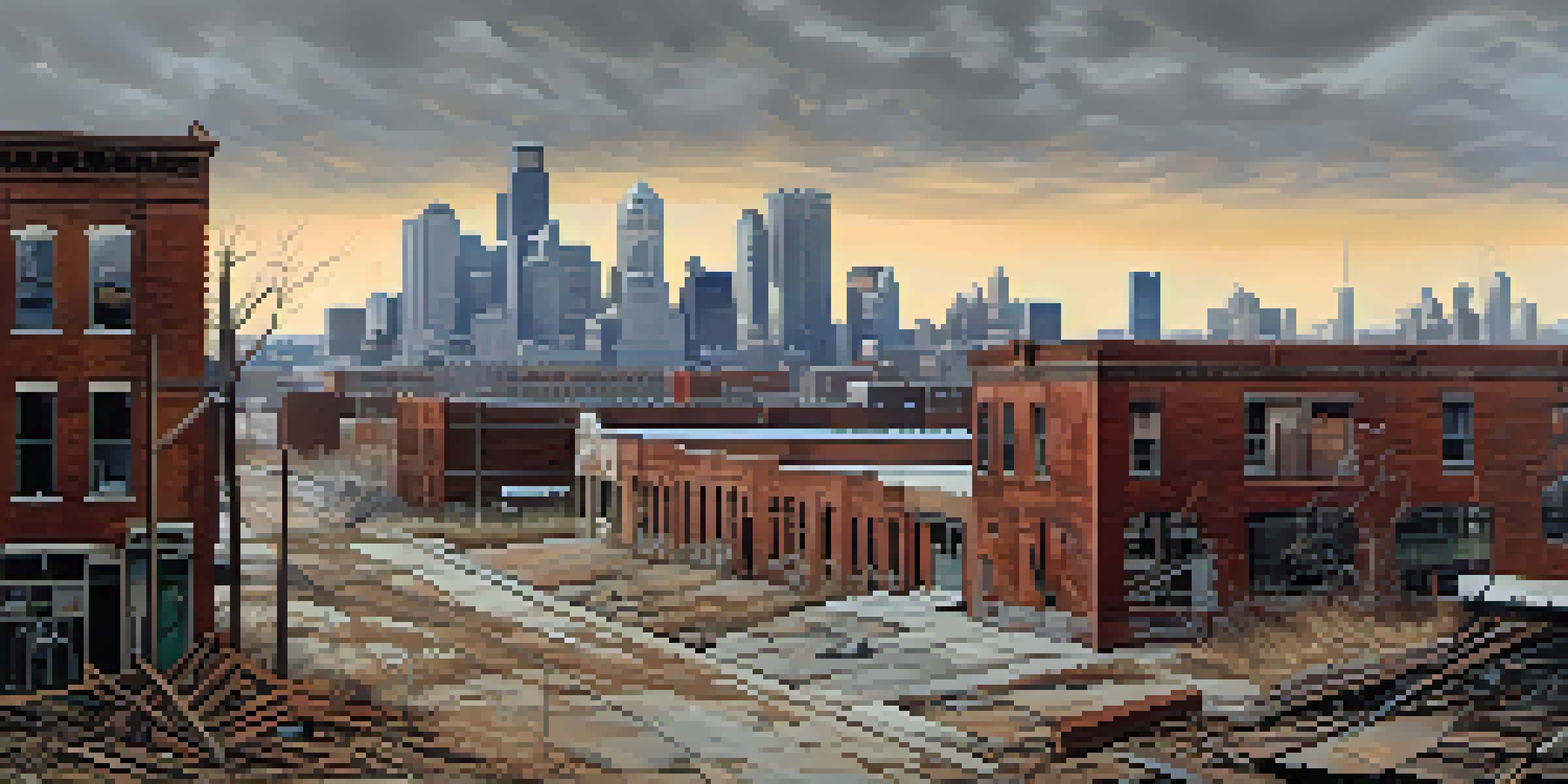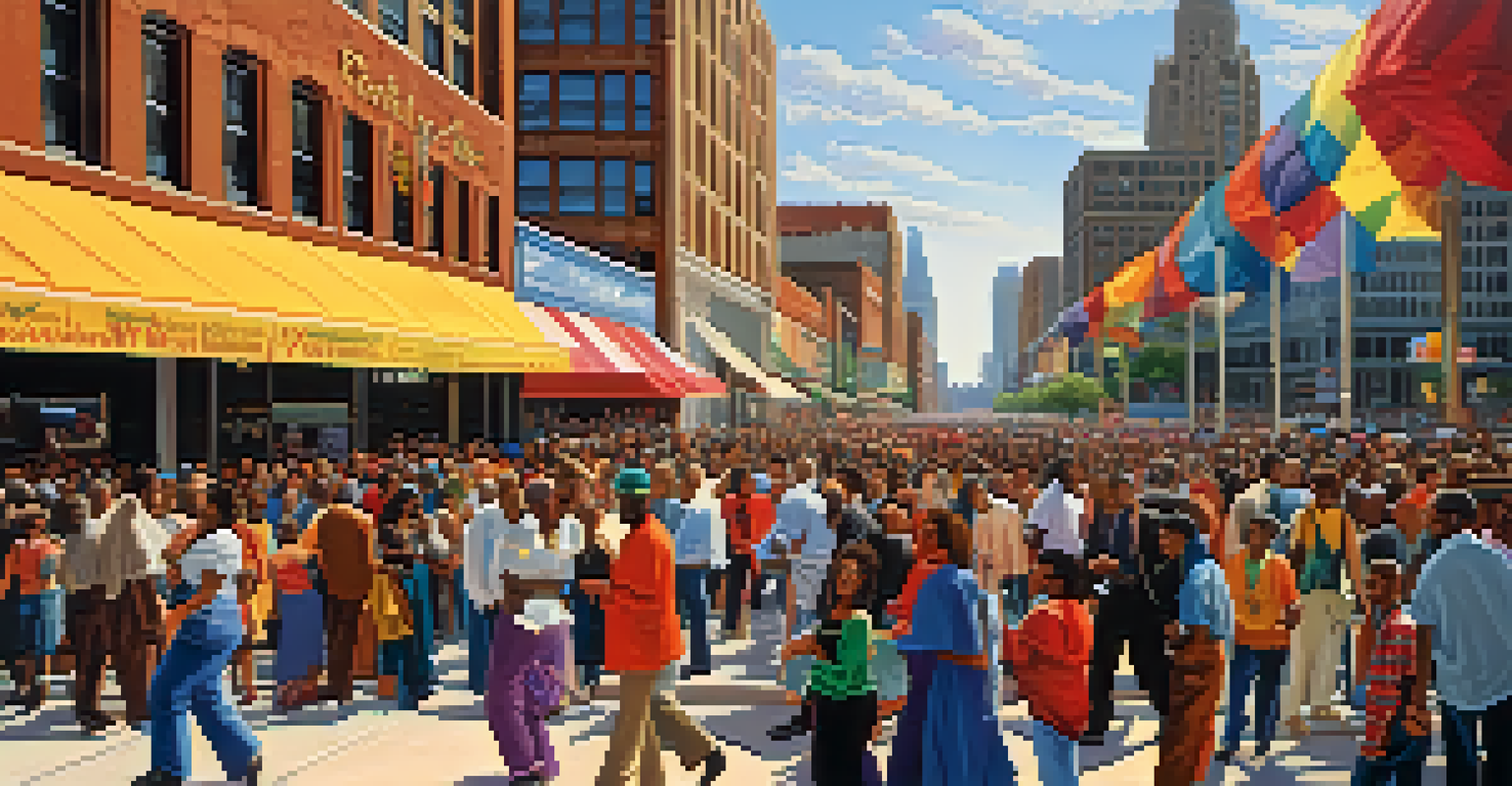Revitalization Efforts: Detroit's Skyline in the 1990s

The Decline of Detroit's Skyline in the 1980s
The 1980s were tough for Detroit, marked by economic downturns and population loss. Many iconic buildings fell into disrepair, creating a skyline that reflected the city's struggles. Once-bustling neighborhoods were now ghost towns, and the skyline seemed to tell a story of decline rather than vibrancy.
Every city has a story to tell, and Detroit's story reflects resilience and renewal.
As industries closed and jobs disappeared, the city faced a significant identity crisis. Residents felt the weight of a city that was once the heart of the American automobile industry. The skyline, which had symbolized growth and prosperity, now stood as a stark reminder of what was lost.
Yet, amidst this gloom, the seeds of revitalization began to sprout. Community leaders and visionaries started to dream about a brighter future, setting the stage for transformative efforts in the coming decade.
The Birth of a Revitalization Movement
By the early 1990s, a newfound sense of hope emerged in Detroit. Local leaders, businesses, and residents came together to create a vision for revitalization. This collaborative spirit paved the way for initiatives aimed at not just restoring buildings, but also rebuilding community pride.

Key players included organizations like the Detroit Economic Growth Corporation, which sought to attract investment and stimulate growth. They focused on revitalizing key areas, such as the downtown district, which had become a focal point for redevelopment efforts.
Detroit's Skyline Reflected Decline
In the 1980s, Detroit's skyline symbolized the city's economic struggles and loss of identity.
This grassroots movement wasn't just about physical structures; it was about creating a livable, vibrant city once again. The vision was clear: a skyline that reflected the resilience and spirit of Detroit's people.
Key Projects Reshaping the Skyline
Several significant projects emerged during this revitalization phase, fundamentally changing Detroit's skyline. One of the most notable was the renovation of the historic Fox Theatre, which reopened in 1988 and became a cultural cornerstone for the city. Its stunning architecture and vibrant programming attracted both locals and tourists alike.
Revitalization is not just about buildings; it's about reimagining a community's spirit.
Another pivotal project was the construction of the Detroit Renaissance Center, completed in 1977 but gaining traction in the 1990s as a symbol of renewal. This complex created a new focal point for business and tourism, showcasing Detroit's potential for growth.
These projects not only revitalized the skyline but also fostered a sense of community pride. They served as reminders that Detroit was a city on the mend, ready to reclaim its status as a thriving urban center.
The Role of Public-Private Partnerships
Public-private partnerships played a crucial role in the revitalization of Detroit's skyline during the 1990s. By pooling resources and expertise, these collaborations allowed for ambitious projects that would have been difficult to achieve otherwise. The synergy between the public sector and private investors resulted in innovative solutions to urban challenges.
For instance, the collaboration between the city and private developers led to the renovation of historic buildings and the construction of new developments. This not only improved the skyline but also created jobs and stimulated the local economy.
Revitalization Through Collaboration
The 1990s saw a revival in Detroit driven by public-private partnerships and community involvement.
Ultimately, these partnerships demonstrated the power of collaboration in driving change. As businesses and government entities united for a common cause, they laid the groundwork for a brighter future for Detroit.
Cultural and Artistic Revitalization
Alongside physical revitalization, a cultural renaissance took root in Detroit during the 1990s. Artists, musicians, and creatives flocked to the city, drawn by its rich history and burgeoning art scene. This influx of talent transformed the city into a vibrant hub of creativity and innovation.
The Detroit Institute of Arts became a focal point for cultural engagement, showcasing local and international artists. Events like the Detroit Electronic Music Festival celebrated the city's unique musical heritage, drawing visitors from around the world.
This cultural revival played a vital role in reshaping the city's identity. The arts became a vehicle for community expression, highlighting Detroit's resilience and ability to thrive despite adversity.
Community Involvement in Revitalization Efforts
Community involvement was at the heart of Detroit's revitalization efforts during the 1990s. Residents took an active role in shaping their neighborhoods, organizing grassroots initiatives to improve local conditions. This engagement fostered a sense of ownership and pride among citizens, propelling the revitalization movement forward.
Organizations like the Detroit Community Development Project empowered residents to advocate for their needs and desires. By providing resources and support, these initiatives encouraged collaboration between citizens and local government.
Cultural Renaissance Fueled Growth
A vibrant cultural scene emerged in the 1990s, enhancing Detroit's identity and attracting new talent.
As community voices became integral to the revitalization process, a stronger, more connected city began to emerge. This collective effort showcased the power of unity in driving meaningful change.
Lessons Learned from Detroit's Skyline Revival
The revitalization of Detroit's skyline in the 1990s offers valuable lessons for other cities facing similar challenges. One key takeaway is the importance of collaboration among various stakeholders, including government, businesses, and community members. When these groups work together, they can create a shared vision that benefits everyone.
Another lesson lies in the significance of cultural and artistic investment. By supporting local artists and cultural initiatives, cities can foster a vibrant atmosphere that attracts both residents and visitors.

Ultimately, Detroit's journey serves as a reminder that revitalization is possible, even in the face of adversity. With determination, creativity, and collaboration, cities can reinvent themselves and build a brighter future.